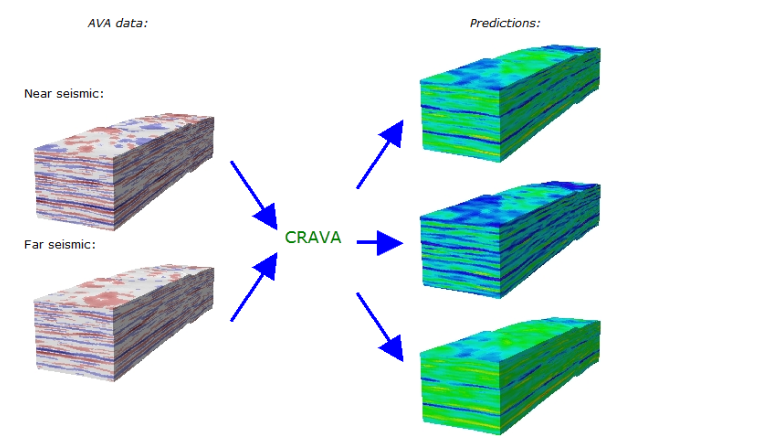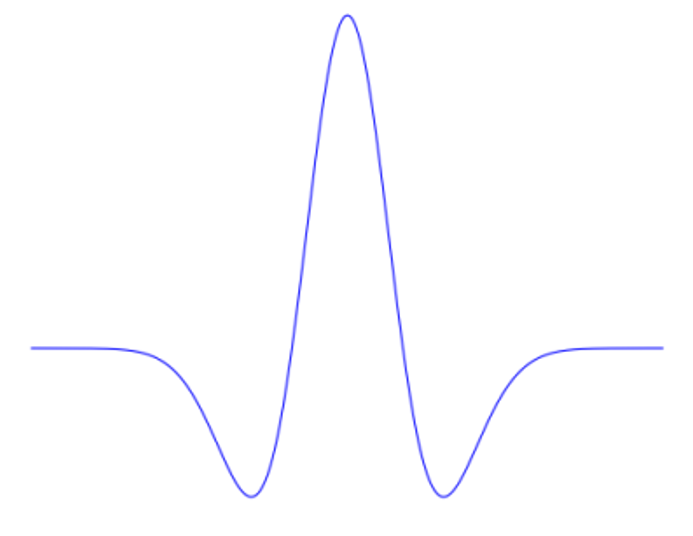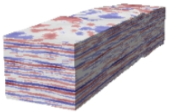CRAVA - Elastic Inversion of Seismic Amplitudes
CRAVA - Elastic Inversion of Seismic Amplitudes
Main | Mathematical Methods | CRAVA User Guide | Download
NR has developed elastic inversion software called CRAVA in collaboration with Equinor. CRAVA is an acronym for "Conditioning Reservoir variables to Amplitude Versus Angle data." CRAVA calculates elastic properties such as density, P- and, S-velocity from seismic amplitude cubes. Input data are amplitude cubes stacked at different angles and corresponding wavelets. Output are cubes of inverted elastic properties. CRAVA also offers the possibility to investigate the accuracy in the results by calculating uncertainties, or by simulating (Monte Carlo) cubes of possible elastic properties.
CRAVA has been tested on several oil fields.
For details and examples please have a look at the CRAVA user manual that has an extensive introduction to concepts and possibilities.
Crava can be downloaded here.
Crava Features
Crava main feature is to perform an elastic inversions, but other features included are estimation mode to only estimate background model, wavelet or prior correlations and forward mode to generate seismic data.
CRAVA also has facies predictions and a rock physics template.
Elastic Inversion
Crava performs the seismic version and gives the prediction or "the most probable" elastic properties given the data. The prediction is unique given the seismic data and the assumptions about the wavelet and the physical models.

Estimation mode
Checks input data and performs estimation of lacking information for inversion. Will estimate a background model, wavelet and/or prior correlations.


Forward modelling
Create a seismic response from background model. This shows what seismic respons CRAVA expects from a given set of elastic parameters.

Facies predictions
The facies probabilities are computed based on the inversion results and a distribution for inversion values given facies computed from filtered well logs, where the filter is defined by the inversion.
.png)
Rock physics
The idea behind the rock physics template is to be able to model the density and elastic properties of a fluid-filled rock in a very flexible way, by selecting from and possibly combining many different rock physics theories
CRAVA Properties
CRAVA is fast:
- Ten million grid cells are processed in less than ten minutes.
- The processing time is proportional to the size of the problem.
CRAVA is based on standard physical approximations:
- Seismic amplitudes are related to elastic parameters through convolution of the wavelet with the seismic reflection coefficients.
- Angular dependent reflection coefficients are calculated from the Zoeppritz equation.
CRAVA calculates any set of seismic parameters in an isotropic, inhomogeneous earth model:
- P-wave velocity
- S-wave velocity
- Density
- Vp/Vs ratio
- Acoustic impedance
- Shear impedance
- Lamé coefficients
- Poisson ratio
CRAVA can use zero-offset data:
- Although CRAVA is intended for elastic inversion, it is possible to use a single zero-offset input cube. The inverted output will then be seismic impedance.
CRAVA accounts for spatial continuity:
- Sedimentary rocks and their elastic properties have strong spatial continuity. This is taken care of by CRAVA by using spatial correlations (variograms) to model the elastic properties.
- It is also known that seismic measurement errors are coloured, that is, the errors have spatial and temporal dependencies. This is caused by the processing techniques used for seismic data and by spatial averaging in the stacking process. CRAVA takes this effect into consideration.
CRAVA evaluates the uncertainty:
- In addition to the inverted elastic properties, variance in the inverted elastic properties and their internal spatial correlation can be calculated. The latter is of importance when conditioning the elastic properties to well observations.
- The uncertainty in the result can be evaluated using stochastic simulation (Monte Carlo) of cubes of elastic properties. The variability in these alternative cubes will depend on the accuracy of the inversion.
CRAVA can add spatial structure below seismic resolution:
- Seismic data are band limited so small scale variations are invisible to seismic investigations. When using stochastic simulation, CRAVA adds small scale variations with correct spatial heterogeneity to the inverted cubes. This gives cubes with a realistic appearence. This is illustrated above; compare the predicted cubes to the simulated cubes.
Publications
The methods used by CRAVA are based on:
- Arild Buland, Odd Kolbjørnsen and Henning Omre (2003) Rapid spatially coupled AVO inversion in the Fourier domain GEOPHYSICS,VOL.68 NO.3 (MAY-JUNE 2003) P.824-836
Scientific presentations about CRAVA
- Geostatistical AVO Inversion on a Deep-water Oil Field presented at Petroleum Geostatistics 2007, Cascais, Portugal.
- Geostatistical AVO inversion on Smørbukk Sør presented at SEG 2006 76th Annual Meeting
- Bayesian AVO Inversion and Application to a Case Study presented at Production Geoscience 2005

Financing
- Equinor
- The Research Council of Norway
- NORSAR
Partners
Equinor


